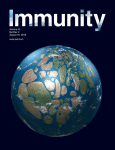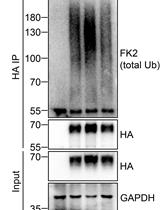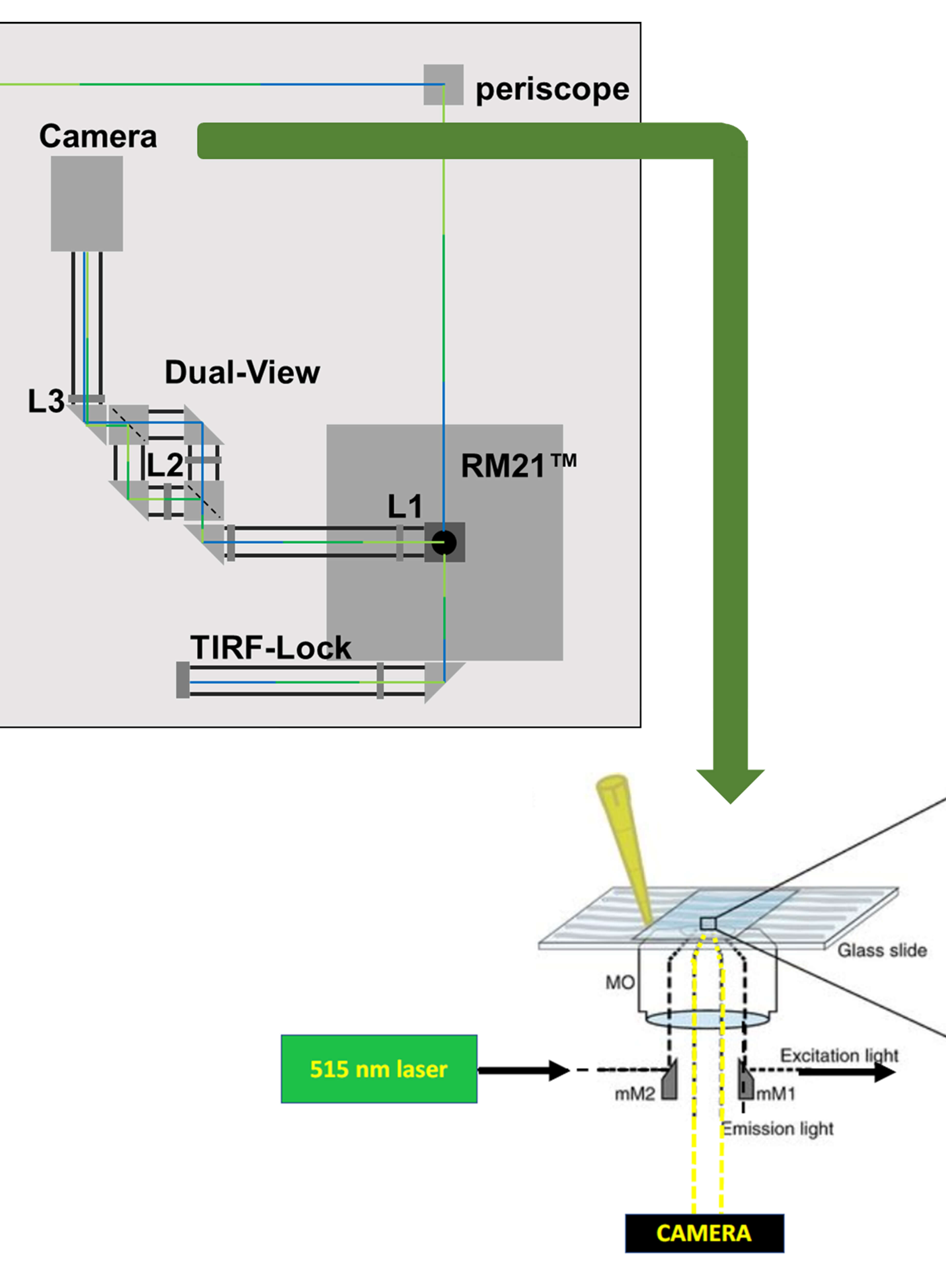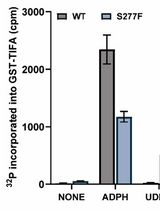- EN - English
- CN - 中文
Phos-tag Immunoblot Analysis for Detecting IRF5 Phosphorylation
Phos-tag免疫印迹分析检测IRF5磷酸化
发布: 2017年05月20日第7卷第10期 DOI: 10.21769/BioProtoc.2295 浏览次数: 15341
评审: Alka MehraFabienne C. FieselShahzada KhanAnonymous reviewer(s)
Abstract
While the activation of the transcription factor interferon regulatory factor 5 (IRF5) is critical for the induction of innate immune responses, it also contributes to the pathogenesis of the autoimmune disease systemic lupus erythematosus (SLE). IRF5 phosphorylation is a hallmark of its activation in the Toll-like receptor (TLR) pathway, where active IRF5 induces type I interferon and proinflammatory cytokine genes. By using the phosphate-binding molecule Phos-tag, without either radioisotopes or phospho-specific antibodies, the protocol described here enables detection of the phosphorylation of both human and murine IRF5, as well as that of other proteins.
Keywords: IRF5 (IRF5)Background
In the TLR-MyD88 pathway, IRF5 is activated through post-translational modifications such as ubiquitination and phosphorylation, and then active IRF5 translocates into the nucleus and induces its target genes (Takaoka et al., 2005; Balkhi et al., 2008; Tamura et al., 2008; Hayden and Ghosh, 2014). Regarding the activation status of IRF5 in SLE, it has been reported that IRF5 accumulates in the nucleus in monocytes of SLE patients (Stone et al., 2012). Furthermore, we recently showed in an SLE murine model that IRF5 hyperactivation (e.g., elevated phosphorylation) leads to the development of an SLE-like disease (Ban et al., 2016). Therefore, analyzing the activation status of IRF5 is important for studying SLE as well as innate immune responses. Phosphorylation is central to the activation of IRF5, as numerous studies have revealed the functional phosphorylation sites of IRF5 by site-directed mutagenesis and/or mass spectrometry (Barnes et al., 2002; Lin et al., 2005; Chen et al., 2008; Chang Foreman et al., 2012; Lopez-Pelaez et al., 2014; Ren et al., 2014). However, antibodies specific for these phosphorylation sites are not commercially available. In addition, phosphorylated IRF5 is normally not separated from non-phosphorylated IRF5 using standard SDS-PAGE. We thus utilized the functional molecule Phos-tag, which binds specifically to the phosphate group via metal ions (Kinoshita et al., 2006). Without using radioisotopes or phospho-specific antibodies, this protocol enables the detection of multiple phosphorylations of the IRF5 protein as up-shifted bands in the resulting immunoblot analysis (Figure 1). This protocol can be applied for detecting the phosphorylation of other proteins if a specific antibody for the total protein of the target protein is available.
Figure 1. Schematic of Phos-tag immunoblot analysis. Phos-tag binds specifically to a phosphate group on the target protein via metal ions, such as Zn2+ or Mn2+. Non-phosphorylated and phosphorylated forms of the target protein (IRF5 in this figure) are separated by SDS-PAGE using acrylamide conjugated with Phos-tag, and then detected by immunoblot analysis using an appropriate specific antibody. The mobility shift of the phosphorylated protein is caused by trapping of its phosphate groups by the polyacrylamide gel-conjugated Phos-tag. Thus, multiple phosphorylations of IRF5 appear as different up-shifted bands, whose mobility shift increases with the phosphorylation level of each IRF5 molecule.
Materials and Reagents
- Tips (BM Equipment, catalog numbers: BMT-10G and BMT-200 ; Corning, catalog number: 4846 )
- Disposable pipette (Greiner Bio One International, catalog numbers: 606160 and 607160 )
- Microcentrifuge tube (Greiner Bio One International, catalog number: 616201 )
- Filter paper (GE Healthcare, catalog number: 3030-6461 )
- Polyvinylidene fluoride (PVDF) membrane (EMD Millipore, catalog number: IPVH00010 )
- Bio-Rad Protein Assay (Bio-Rad Laboratories, catalog number: 5000006 )
- Bovine serum albumin (BSA) (Wako Pure Chemical Industries, catalog number: 017-23294 )
- Lambda protein phosphatase (λPPase) (New England Biolabs, catalog number: P0753 )
- Calf intestinal alkaline phosphatase (CIAP) (Takara Bio, catalog number: 2250 )
- Manganese(II) chloride tetrahydrate (MnCl2·4H2O) (Wako Pure Chemical Industries, catalog number: 136-15301 )
- Bromophenol blue (BPB) (Wako Pure Chemical Industries, catalog number: 029-02912 )
- Marker III (Wako Pure Chemical Industries, catalog number: 230-02461 )
- Anti-IRF5 antibody (Abcam, catalog number: ab21689 )
- MaxBlot solution 1 (MEDICAL & BIOLOGICAL LABORATORIES, catalog number: 8455-100 )
- Horseradish peroxidase-conjugated anti-rabbit IgG antibody (GE Healthcare, catalog number: NA934 )
- ECL Prime (GE Healthcare, catalog number: RPN2236 )
- Immunostar® LD (Wako Pure Chemical Industries, catalog number: 292-69903 )
- Sodium chloride (NaCl) (Wako Pure Chemical Industries, catalog number: 191-01665 )
- Na2HPO4·12H2O (Wako Pure Chemical Industries, catalog number: 196-02835 )
- Potassium chloride (KCl) (Wako Pure Chemical Industries, catalog number: 163-03545 )
- Potassium dihydrogen phosphate (KH2PO4) (Wako Pure Chemical Industries, catalog number: 169-04245 )
- NP-40 (Nacalai Tesque, catalog number: 25223-75 )
- Sodium deoxycholate (Nacalai Tesque, catalog number: 10712-12 )
- SDS (Nacalai Tesque, catalog number: 08933-05 )
- cOmplete protease inhibitor cocktail tablets (Roche Diagnostics, catalog number: 11836170001 )
- PhosSTOP phosphatase inhibitor cocktail tablets (Roche Diagnostics, catalog number: 04906837001 )
- Glycerol (Nacalai Tesque, catalog number: 17018-25 )
- 2-mercaptoethanol (Wako Pure Chemical Industries, catalog number: 131-14572 )
- Tween 20 (Nacalai Tesque, catalog number: 28353-85 )
- Skim milk (Morinaga Milk Industry)
- Acrylamide (Nacalai Tesque, catalog number: 00809-85 )
- N,N’-methylenebisacrylamide (bis) (Wako Pure Chemical Industries, catalog number: 138-06032 )
- Phos-tag acrylamide (Wako Pure Chemical Industries, catalog number: AAL-107 )
- APS (Wako Pure Chemical Industries, catalog number: 016-08021 )
- TEMED (Wako Pure Chemical Industries, catalog number: 205-06313 )
- Glycine (Nacalai Tesque, catalog number: 17109-35 )
- Tris (Nacalai Tesque, catalog number: 35406-91 )
- MOPS (Dojindo, catalog number: 343-01805 )
- Sodium bisulfite (Nacalai Tesque, catalog number: 31219-55 )
- Methanol (Wako Pure Chemical Industries, catalog number: 139-01827 )
- EDTA.2Na (Dojindo, catalog number: 345-01865 )
- 7.5% Phos-tag precast gel (Wako Pure Chemical Industries, catalog number: 192-17381 )
- Phosphate-buffered saline (PBS, 1x) (see Recipes)
- EDTA-free lysis buffer (see Recipes)
- 1% NP-40 TBS buffer (see Recipes)
- 6x sample buffer (see Recipes)
- Tris-buffered saline containing Tween 20 (TBS-T) (see Recipes)
- Blocking solution (see Recipes)
- Handmade Phos-tag acrylamide gel (see Recipes)
- Separating (lower) gel
- Stacking (upper) gel
- Tris-glycine running buffer (see Recipes)
- Tris-MOPS running buffer (see Recipes)
- Transfer buffer (see Recipes)
Equipment
- Refrigerated mini-centrifuge (TOMY SEIKO, model: KITMAN-24 )
- Microplate reader with 595 nm wavelength available (Tecan, model: F039300REMOTER )
- Heat block (Major Science, model: MD-02N )
- Power supply (Bio-Rad Laboratories, catalog number: 1645070 )
- Gel tank (NIHON EIDO, model: NA-1012 )
- Horizontal shaker (YAMATO SCIENTIFIC, model: MK200D )
- Semi-dry blotter (NIHON EIDO, model: NA-1512 )
- Blotting roller (Bio-Rad Laboratories, catalog number: 1651279 )
- Luminescent image analyzer (GE Healthcare, model: ImageQuant LAS 4000 mini )
Procedure
文章信息
版权信息
© 2017 The Authors; exclusive licensee Bio-protocol LLC.
如何引用
Sato, G. R., Ban, T. and Tamura, T. (2017). Phos-tag Immunoblot Analysis for Detecting IRF5 Phosphorylation. Bio-protocol 7(10): e2295. DOI: 10.21769/BioProtoc.2295.
分类
细胞生物学 > 细胞信号传导 > 磷酸化
生物化学 > 蛋白质 > 修饰
您对这篇实验方法有问题吗?
在此处发布您的问题,我们将邀请本文作者来回答。同时,我们会将您的问题发布到Bio-protocol Exchange,以便寻求社区成员的帮助。
Share
Bluesky
X
Copy link












